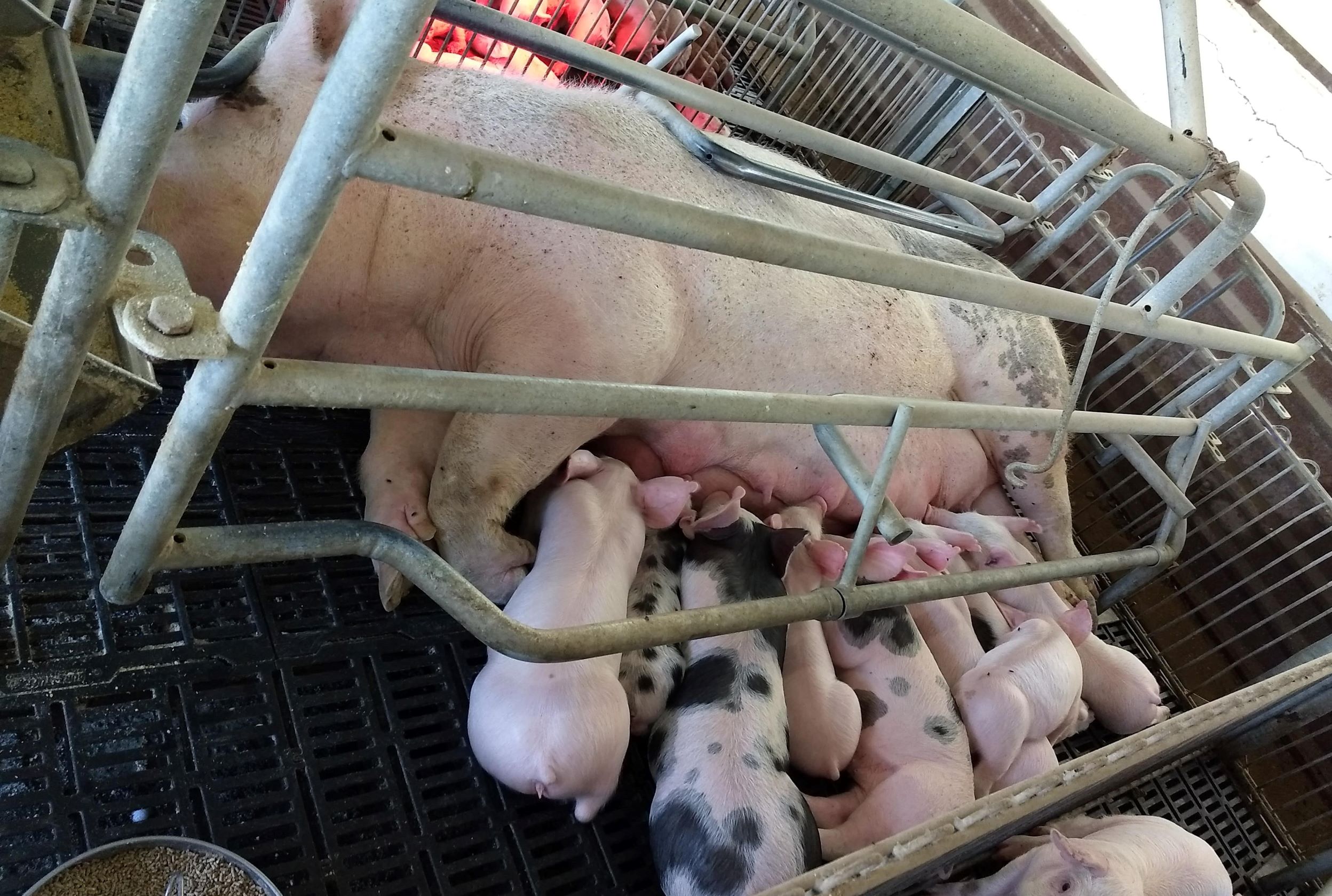Similitud genética de serovares de Salmonella aisladas de granjas de cerdos en Sinaloa, México
Palabras clave:
cerdos, PFGE, Salmonella, serovares, AnatumResumen
Salmonella es un patógeno importante como agente causal de enfermedades gastroentéricas por consumo de alimentos contaminados. Para determinar la similitud genética de serovares de Salmonella, 340 muestras de heces y tejido del íleon fueron tomadas de cerdos de diferentes edades y etapas fisiológicas de dos granjas ubicadas en la zona centro del Estado de Sinaloa; las muestras del íleon fueron tomadas en rastro TIF. La similitud génica de los serovares se realizó mediante digestión con la enzima de restricción XbaI y electroforesis en gel de campo pulsado (PFGE). En 32 de las muestras analizadas se aisló Salmonella y los serovares Anatum, Seftenberg, Untipable, Javiana, Tokoin, Newport, Typhimurium, Weltevreden, Serrakunda, Muenchen, Grupo C2, Grupo E1 (E2-E4), Grupo E1, Grupo C1 y Grupo F. El serovar Anatum, que se aisló con mayor frecuencia, tuvo una similitud genética de 87.5 – 100%, el Grupo E1 del 87.5 -100%, Serrekunda del 88.9 -100%, Muenchen del 100%, Senftenberg 96.6% y Newport 75.9%; éstos presentaron un coeficiente de Jaccard mayor a 0.75 en el análisis de PFGE, por lo que se consideraron clonas bacterianas. En conclusión, el porcentaje de similitud genética observado fue alto, lo que indica una posible fuente de contaminación cruzada en las unidades de producción porcina analizadas.
http://dx.doi.org/10.21929/abavet2022.28
e2021-87
Citas
HERIKSTAD H, Motarjemi Y, Tauxe RV. 2002. Salmonella surveillance: a global survey of public health serotyping. Epidemiol. Infect. 129(1):1-8. ISSN: 0950-2688.
https://doi.org/10.1017/s0950268802006842
BERNAD-ROCHE M, Casanova-Higes A, Marín-Alcalá CM, Cebollada-Solanas A, and Mainar-Jaime RC. 2021. Salmonella Infection in Nursery Piglets and Its Role in the Spread of Salmonellosis to Further Production Periods. Pathogens. 10(2):1-14. ISSN: 2076-0817. https://doi.org/10.3390/pathogens10020123
CARDOZO-BERNAL AM, Ramón LF, Poutou-Piñales RA, Carrascal-Camacho AK, Zambrano DC. 2012. Electroforesis en Gel de Campo Pulsado (PFGE) para la diferenciación molecular de Listeria monocytogenes. Univ Sci. 18(2):203-222. ISSN: 0122-7483. https://doi.org/10.11144/Javeriana.SC18-2.egcp
CASANOVA HIGES A, Marín Alcalá CM, Andrés Barranco S, Cebollada Solanas A, Alvarez J and Mainar Jaime RC. 2019. Weaned piglets: another factor to be considered for the control of Salmonella infection in breeding pig farms. Veterinary Research. 50(45): 1-11; ISSN: 1297-9716. https://doi.org/10.1186/s13567-019-0666-7
DE BUSSER EV, Maes D, Houf K, Dewulf J, Imberechts H, Bertrand S, De Zutter L. 2011. Detection and characterization of Salmonella in lairage, on pig carcasses and intestines in five slaughterhouses. Int. J. Food Microbiol. 145(1):279–286. ISSN: 0168-1605. https://doi.org/10.1016/j.ijfoodmicro.2011.01.009
DOS SANTOS A, Ferrari RG, Conte-Junior CA. 2019. Virulence Factors in Salmonella Typhimurium: The Sagacity of a Bacterium. Current microbiology. 76(6):762–773. ISSN: 0343-8651. https://doi.org/10.1007/s00284-018-1510-4
DOS SANTOS BL, Quintana CV, Viana C, Konrad BRC, Camargo CA, Paes de Almeida NPJ, Nero LA, Destro MT. 2019. Prevalence, Antimicrobial Resistance, and Diversityof Salmonella along the Pig Production Chain in Southern Brazil. J pathogens (Basel, Switzerland). 8(4):1-10. ISSN: 2076-0817. https://doi.org/10.3390/pathogens8040204
GOMES-NEVES E, Antunes P, Tavares A, Themudo P, Cardoso MF, Gärtner F, Costa JM, Peixe L. 2012. Salmonella cross-contamination in swine abattoirs in Portugal: Carcasses, meat and meat handlers. Int. J. Food Microbiol. 157(1):82–87. ISSN: 0168-1605. https://doi.org/10.1016/j.ijfoodmicro.2012.04.015
HUNG-CHIH K, Tsai-Ling L, Dan-Yuan L, Chiou-Lin C, Pei-Chen C, Shiu-Yun L, Jung-Che K, Ying-Shu L, Chun-Hsing L, Chi-Sen T, Chien-Shun C. 2014. An Association of Genotypes and Antimicrobial Resistance Patterns among Salmonella Isolates from Pigs and Humans in Taiwan. Plos One. 9(4):e95772. ISSN: 1932-6203.
https://doi.org/10.1371/journal.pone.0095772
KICH JD, Coldebella A, Morés N, Nogueira MG, Cardoso M, Fratamico PM, Call JE, Fedorka-Cray P, Luchansky JB. 2011. Prevalence, distribution, and molecular characterization of Salmonella recovered from swine finishing herds and a slaughter facility in Santa Catarina, Brazil. Int. J. Food Microbiol. 151(3):307- 313. ISSN: 0168-1605.
https://doi.org/10.1016/j.ijfoodmicro.2011.09.024
KURELJUSIC JM, Dmitrić MP, Vidanović DS, Teodorović VB, Kureljušić, BI, Velhner MJ, Karabasil NR. 2017. Prevalence of Salmonella enterica in slaughtered pigs in Serbia: Serotyping, PFGE-genotyping and antimicrobial resistance. Journal of infection in developing countries. 11(8): 640-645. ISSN: 1972-2680. https://doi.org/10.3855/jidc.9311
MAGISTRALI C, Dionisi AM, De Curtis P, Cucco L, Vischi O, Scuota S, Zicavo A, Pezzotti G. 2008. Contamination of Salmonella spp. in a pig finishing herd, from the arrival of the animals to the slaughterhouse. Res. Vet. Sci. 85(2):204-207. ISSN: 0034-5288.
https://doi.org/10.1016/j.rvsc.2007.12.002
PIRES SM, Vieira AR, Hald T, Cole D. 2014. Source attribution of human salmonellosis: an overview of methods and estimates. Foodborne Pathog. 11(9):667-676. ISSN: 1535-3141. https://doi.org/10.1089/fpd.2014.1744
PIRES SM, de Knegt L, Hald T. 2011. Estimation of the relative contribution of different food and animal sources to human Salmonella infections in the European Union. EFSA Supporting. 8(8):184E. ISSN:1831-4732. https://doi.org/10.2903/sp.efsa.2011.EN-184
SANTANA AM, da Silva DG, Maluta RP, Pizauro L, Simplício K, Santana CH, Rodrigues S, Rodrigues D, Fagliari JJ. 2020. Comparative Analysis Using Pulsed-Field Gel Electrophoresis Highlights a Potential Transmission of Salmonella Between Asymptomatic Buffaloes and Pigs in a Single Farm. Frontiers in veterinary science. 7:2-7. ISSN: 2297-1769. https://doi.org/10.3389/fvets.2020.552413
SIMONS RRL, Hill AA, Swart A, Kelly L, Snary EL A. 2015. Transport and lairage model for Salmonella transmission between pigs applicable to EU member States. Risk Anal. 36(3):482-497. ISSN:1539-6924. https://doi.org/10.1111/risa.12390
SWAMINATHAN B, Barrett TJ, Hunter SB, Tauxe RV. 2001. PulseNet: the molecular subtyping network for foodborne bacterial disease surveillance, United States. Emerg Infect Dis. 7(3):382-389. ISSN: 1080-6059. https://doi.org/10.3201/eid0703.010303
VILLALPANDO-GUZMÁN S, Vázquez-Quiñones CR, Natividad-Bonifacio I, Curiel-Quesada E, Quiñones-Ramírez EI, Vázquez-Salinas C. 2017. Frecuencia, susceptibilidad antimicrobiana y patrón de adherencia de Salmonella enterica aislada de carne de pollo, res y cerdo de la Ciudad de México. Rev Chilena Infectol. 34(5):458-466. ISSN: 0716-1018. http://dx.doi.org/10.4067/S0716-10182017000500458



